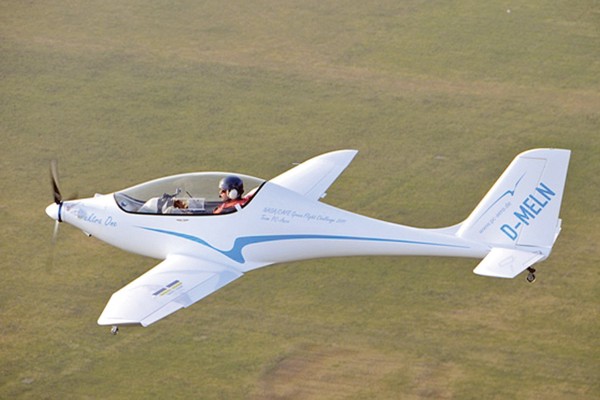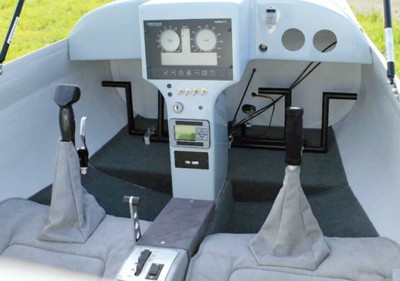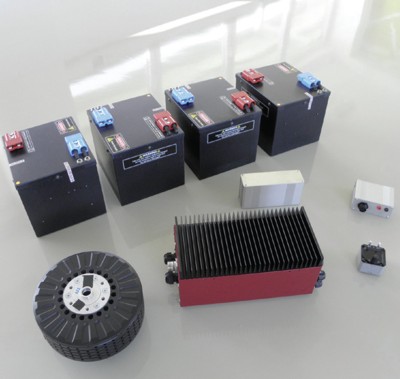
IN FLIGHT = PC-Aero’s Elektra One can be flown for 3 hours without noise and with lower operation costs than conventionally powered aircraft.
– COPYRIGHT JEAN-MARIE URLACHER INFO-PILOTE.JPG

CLEAN & SIMPLE – Randall Fishman’s third generation electric aircraft is neat
and clean as befits such an aircraft. Naturally, electronic instruments are featured

MOTORGLIDER DESIGN – Looking very European – but most definitely an
American design through and through – the ElectraFlyer-X has the smooth lines of a
motorglider.

AIR SLIPPER – Only in an electric-powered aircraft (other than one with the engine
in the rear transmitting to the nose) could the cowling aft of the prop be so small.

MORE NEEDED? – If you’re used to looking at a tachometer
and fuel gauge, these instruments may look foreign, but you
might want to get used to them as electric continues to invade
aviation.

GERMAN ENGINEERING – The Elektra One uses a modern
composite glass and carbon structure, a single, retractable
main wheel, and is said to have a propeller efficiency of 90%
driven by a highly efficient electric drive.
– COPYRIGHT JEAN-MARIE URLACHER INFO-PILOTE.JPG

ELECTRA PRINCE — Prince Albert of Monaco made an appearance at Aero in conjunction
with the electric aircraft prizes. He took a seat in the Elektra One as
designer Calin Gologan (in striped tie) explains the concept.

ELECTRIC DESIGNER – The long, tall designer of the award-winning Elektra
One is Calin Gologan. Note the single main landing wheel, which can be retracted.

FORMATION FLIGHT? – In this photos it appears a solitary engine nacelle has somehow taxied up between two
Taurus motorgliders, but this one-off G4 airplane was built to win a prize, a big prize.

GRACEFUL JUICER – Electric power outperforms its gasoline-powered counterpart in Pipistrel’s Taurus
Electro G2 motorglider.

BATTERY POWER – Batteries stand in the rear row
with the motor to the left and controller elements in
the lower right. All these parts have been assembled
or designed by Pipistrel for their several electric aircraft
entries.

SOLAR TRAILER – After flying your eTaurus, put it in its traveling hangar
and, presto, the trailer will charge your airplane’s batteries, essentially for
free (after acquisition costs are paid, of course). How cool is that?

VEE-TAILED – Is it any wonder Yuneec’s sleek e430 attracted crowds every day when it first appeared at AirVenture?

LIGHT TAKEOFF – With its 45-foot wingspan, the e430 can take off in 265 feet, climb at 1,320 fpm, cruise at
55 mph, and has a glide ratio of 25:1.

ELECTRIC TRIKE – Yuneec’s tiny little trike with an even tinier motor flies under a high-performance La
Mouette hang glider wing.

Energy Density Primer

Composite Fuselage as “Batteries?”

Winning the LEAP
and Berblinger Prize

LEAN LINES – A studio image reveals the lean lines of the e430 and its gentle curves throughout the design.
Flying with Juice
As an airplane approaches, a whirring sound accompanied by a
barely discernible whine and a mild propeller buzz exhibit a
Doppler effect as the plane passes overhead. What is that curious noise?
We are intimately attuned to internal combustion engine sounds –
some experts claim they can identify the brand and size of an engine
simply by listening to it run. We’re less aware of electric motor noises
because we quickly tune them out. Electric motors run everywhere in
our lives – in our refrigerators, our computers, in our ceiling fans, and
numerous other appliances. Most motors – it’s incorrect to call them an
“engine” – are exceptionally quiet, and that’s a good thing.
One wonders if relatively quiet electric motors on aircraft will invade
our piston-powered world, especially given noise sensitivity at many airports.
Some say, “We’re about to see if electric works.” I say, “We’re seeing
it right now!”
Two years ago, I wrote about ultralights – literally Part 103-compliant
ultralights – operating remarkably well on electric power.1 In the ensuing
months, more projects have been announced. With a whole issue of
Light Sport and Ultralight Flying we might cover the entire field. To
give a picture of the state of development, I’ll update coverage of four
aircraft including projects from two of the original players.
Our four include the ElectraFlyer X, a ground-up new design from
electric power pioneer Randall Fishman; the prize-winning Electra One,
Light Sport and Ultralight Flying Pilot’s Report
a nifty single-seater with a retractable single main wheel; the Pipistrel
Taurus and variations on the theme from a company moving fast; and
several projects from the prolific Shanghai company, Yuneec. The electric
phenomenon is global. Our examples hail from USA, Germany, Slovenia,
and China.
ELECTRAFLYER ELECTRIC AIRPLANES
Our first example is first in other ways. Randall Fishman brought a product, not
simply to airshows but to market way back in ’07. In electric airplane terms – much
like “Internet time” – it seems like ancient history since airshow visitors saw his
ElectraFlyer Trike. Fishman has stayed active in the game with two follow-on developments,
though the real story may be the way his company can supply electric
propulsion hardware to builders of any airplane.
His subsequent single-seat ElectraFlyer-C, essentially a modified Moni motorglider,
can fly under power for up to 90 minutes (or 60 minutes if landing with the equivalent
of a legal, day VFR fuel reserve). A portable 110-volt charger can recharge the
batteries in about 6 hours.A more powerful 220-volt charger can do the job in 2 hours
if a suitable outlet is available. Estimated “fuel” cost for such a flight is less than 75
cents, Fishman reports.
Batteries could last 10 years, assuming typical use and recharge cycles. Given a
power supply cost at about $7,500, that’s $750 per year plus recharges, call it $1,000
even. At $4 per gallon, that’s 250 gallons worth and at 5 gallons per hour, that’s 50
hours of flying per year. Any greater amount of annual flying is almost free because
you’ve already covered the cost of the batteries. In a combustion engine aircraft, you
would have to keep buying your favorite fossil fuel.
Having worked out the specs and issues with his Trike and ElectraFlyer-C,
Fishman is completing work on an original 2-seat development, the ElectraFlyer-X.
The beautiful new model has a smooth motorglider look with a high-aspect-ratio
wing powered by Fishman’s proprietary 50-hp motor, motor controller, and battery
solution. For the record, both his ElectraFlyer Trike and the C flew on 28 horsepower.
“The ElectraFlyer-X cruises at 80 mph and has a top speed in straight and level
flight of 100 mph,” reports Fishman. “At the slower speed, duration is 1.5 to 2 hours.”
Fishman’s electric motor reliably starts up instantly. The electric powerplant barely
vibrates and you needn’t contend with smelly fuel or oil. Other than prop noise,
the Fishman system is quiet.
Until the ElectraFlyer-X comes to market, you can buy,
today, an ElectraFlyer Trike for about $20,000 for trike, wing,
and batteries with a 45-minute duration. Prices change, so
check with Fishman’s Electric Aircraft Corporation for the latest
information. At press time, the Moni-based ready-to-fly
ElectraFlyer-C was for sale at less than $50,000. This is a oneoff
design, so you should act soon if interested.
For more detailed specifications and info, contact:
Electric Aircraft Corporation 118 Pine Street, Suite 3,
Cliffside Park, NJ 07010. Phone: 561.351.1190 | e-mail:
randall@electraflyer.com | Internet: www.electraflyer.com.
ELEKTRA ONE FROM PC-AERO
Our next example reveals quality German engineering. For
that and its innovations, Elektra One shared in the Lindbergh
prize (see the “Winning the Berblinger Prize and LEAP” sidebar)
awarded in April at the European Aero 2011 event.
Elektra One was designed by PC-Aero. “Using existing technology,
it is possible to fly with a 1- and a 2-seat aircraft without
CO2 emission for more than 3 hours, without noise and for lower
operation costs in comparison with conventionally powered aircraft,”
says Calin Gologan, president of PC-Aero. “This is the
future of leisure aviation as a bridge to the next step: electric
transportation.”
Romanian aeronautical engineer Gologan reports several
advantages of electric powerplants for light aircraft (and these
apply to any electric-powered aircraft): environmental protection
through elimination of CO2 emissions; low noise; long range
(depending on how much battery can be carried); low operating
costs.
Gologan expects to achieve more than 3 hours
flight time, delivering more than a 250-mile range.
He thinks cruise can hit 100 mph (a figure supported
by Fishman’s experience). Noise generated is significantly
restrained in cruise by keeping the propeller
speed at 1,400 rpm.
The developer predicts emission-free flying and
sees environmentally sound machines drawing little
grid power by using solar panels on the hangar for
very low cost recharging. (Also see photo of Pipistrel’s
rolling solar hangar that makes a similar claim.)
PC-Aero’s goal is a total system of aircraft, hangar,
and power selling for less than |100,000 (about
$142,604). Remember, this includes the cost of
hangar and “fuel.”
According to the manufacturer, here are a few specifications
of the single-seat Elektra One: maximum
weight 660 pounds; 28-foot wingspan; maximum
engine power 16 kW (21 hp); empty weight (without
batteries) 220 pounds; maximum battery weight 220
pounds; payload 220 pounds.
The magic isn’t solely the powerplant. The innovative
Elektra One uses a modern composite glass and
carbon structure, and a single, retractable main
wheel. Gologan says the Elektra One has an
advanced aerodynamic design and propeller efficiency
of 90% driven by a highly efficient electric drive.
Addressing media at his PC-Aero company’s booth
at Aero 2011, Gologan explained that he began work
on the Elektra One three years ago with the goal of
optimizing it as a cruising machine. Reportedly this
is why he gave the airplane a relatively short 28-foot
wingspan. Elektra One’s wing has a unique profile,
with a half-span sweep and some remarkable characteristics.
“Test flying showed that I had developed a
highly tolerant wing profile,” says Gologan. “It can fly
at angles of attack as high as 40°, where you can still
use the ailerons and still not stall. The wing also provides
good gliding characteristics shown by a 25:1
glide ratio.”
Power for the first Elektra One was supplied by a
13.5-kilowatt (about 18-hp) electric motor built by
Geiger Engineering, which also makes Elektra One’s
propeller and battery controller. The airplane has a
single, manually retractable landing gear, two small
wingtip wheels, and a variable-pitch propeller.
Gologan claims the Elektra One is only 20% as noisy
as a typical general aviation airplane. He said it
would cost just $49 per hour to operate.
The Elektra One will be certified under Germany’s
ultralight regulations; a 2-seater is in the works.
Certification of the larger model “will not be a problem,
because for years my work was as a certification
engineer,” Gologan says. He expects certification by
the end of 2011. His ultimate goal is a family of electrically
powered airplanes. Principally a designer and
engineer, Gologan’s plan is to hand marketing and
sales duties to NeoWings, a firm based in Augsburg,
Germany.
For more detailed specifications and info, contact:
PC-Aero, Buchenweg 3, 87484 Nesselwang,
Germany. E-mail: calin.gologan@pc-aero.de |
Internet: www.pc-aero.de.
PIPISTREL’S PROJECTS
When I finally met Pipistrel designer Tine Tomazic,
the engineer seemed highly confident in his work.
Tomazic works closely with Ivo Boscarol, general
manager and founder of Pipistrel. Perhaps the company’s
assuredness is justified, since it’s already a big
NASA efficiency competition winner to the tune of
$165,000. No wonder Pipistrel has created the
unusual G4 (see photo) for the 2011 NASA/CAFE
prize of $1.65 million.
“Can electric perform better than conventional
powerplants?” asked Tomazic during a presentation.
“Absolutely!” he said, answering his own question.
Tomazic’s enthusiasm is infectious.
Indeed, Pipistrel is underway with a very impressive
4-seater called Panthera that is proposed to fly
200 mph on a combustion engine, a hybrid engine, or
an all-electric version. For most companies such
claims would sound boastful. Pipistrel might pull it
off. Their Taurus Electro G2 is already for sale and
performing well with electric-only power.
As Tomazic puts it, “For the first time electric
power outperforms its gasoline-powered counterpart
in our Taurus.” He observes that the Taurus
Electro G2 can use a shorter runway, climbs faster
and performs much better than the gasoline-powered
version when it comes to high altitude operations.
All this is possible, thanks to the specially
developed emission-free Pipistrel 40kW electric
power train.
Of course, G2 – a motorglider – is a specialty aircraft
and perhaps electric power will not outperform
a combustion engine in, for example, the Bye
Aerospace electric power conversion of a Cessna
172 Skyhawk. Pipistrel’s airplanes are far sleeker
and lighter for their mission than the dated Cessna
design.
Pipistrel’s custom-developed Lithium batteries
come in two configurations, capable of launching
the Taurus to 4,000 feet or 6,500 feet respectively.
Remember, this is a self-launching sailplane; getting
to an altitude where soaring lift can be found is
the whole point. The batteries are monitored constantly
by Pipistrel’s own battery management system
complete with data logging and battery health
forecasting.
The Taurus’ electric motor weighs only 24 pounds
while developing the equivalent of 54 horsepower.
As Pipistrel’s designers upped the power of their
propulsion unit, they also developed a new propeller,
which they believe has increased efficiency.
Pipistrel has also invented a new set of onboard,
networked avionics that provides a “fly-by-wire
power train management with built-in multi-layer
protection logic,” says the company. Engineers add,
“This represents a great improvement over the system
used in the Taurus Electro prototype, where
everything was handled by the pilot.”
Pipistrel has been pushing the envelope and feels
they have achieved “the absolute pinnacle of today’s
battery technology, combining low weight, high
power and high energy density to levels that
seemed impossible as recently as ’09.” When a battery
cell is performing poorly, the system is able to
signal the need for maintenance.
The proof of Pipistrel’s admirable engineering
may reveal itself at the NASA/CAFE Challenge in
July ’11.
For more detailed specifications and info, contact:
Pipistrel Aircraft, Gori_ka cesta 50a SI-5270
Ajdovina, Slovenia. Phone: 213.984.1237 | e-mail:
info@pipistrel-usa.com |Internet: www.pipistrelusa.com
YUNEEC’S DEVELOPMENTS
Huge amounts of media and public attention
were focused on Yuneec’s smooth, handsome e430 at
AirVenture in the summer of ’09. The 2-seater took
Oshkosh by storm. It appeared practical and workable,
though it isn’t on the market at this time.
“With the e430’s flight times of between 1.5 and 3
hours (depending on configuration), electric flight
now becomes a realistic power source for sport aviation,”
says Yuneec engineers. “Charging times of 3
hours for as little as $5 make electric a genuinely
low-cost way to fly, and with only two main moving
parts in the motor (the bearings), the reliability and maintenance
are like nothing seen before.”
Use of a 6-battery setup in e430 results in 1.5 to 2 hours
of flight and with such an installation, payload remains a
respectable 400 pounds even with a 45-foot wing span. The
long wings ensure efficient electric cruising while adding a
safety factor. Yuneec says a 10-battery setup could fly 2.25
to 2.5 hours, though the up-front investment would be significantly
higher. The rub in electric aircraft is concentrated
in the purchase cost of batteries plus their weight. It is
in this area that development is needed so it’s fortunate for
aviation that auto companies are spending billions in parallel
development. The good news is that electric airplane
developers can take advantage of battery technology
improvements as they arrive.
A 45-foot wingspan gives the e430 a 25:1 glide ratio and
flight tests produced these results: Takeoff in 265 feet at 40
mph; climb rate 1,320 fpm; cruise speed 55 mph; top speed
level flight 93 mph.
As initially developed by Flightstar in the USA, the e-
Spyder took its first flight in July ’09. Yuneec supplied the
eSpyder’s electric power. Flightstar initially mounted the
twin lithium polymer battery packs on either side of the
design’s robust main fuselage tube, though they were subsequently
hidden in a slide-out drawer under the cockpit
floor pan, an excellent location for several reasons.
Flightstar’s stateside experience realized electric
motors are user-friendlier in nearly every
way, but a pilot would have some new learning
to do. For example, experts advise never allowing
lithium polymer batteries to drain completely.
Fortunately, the Yuneec controlling hardware
installed on the eSpyder provides warning systems
to help you manage this task.
Yuneec and Flightstar say batteries will last
for at least 500 cycle charges and Yuneec says
this equates to more than 250 hours of flying.
That many hours with a Rotax 912 would cost
about $5,000 in fuel alone, plus oil, spark plugs,
overhaul costs and more. So, as we’ve seen with
some other entries, batteries for electric motors
represent a similar net flying cost as a gas
engine with fuel, but without the noise, smell, or
mess.
For more detailed specifications and info, contact:
Yuneec International Ltd., 388 Zhengwei
Road, Jinxi Town, Kunshan, Jiangsu, China.
Phone: 011.86.512.5012.1243
| Fax: 011-86-512-5012-1255 | e-mail:
sales@yuneec.com | Internet: yuneeccouk.site.securepod.com/index.
THE END OF ELECTRIC?
This may be the end of this article, but it won’t
be my last about electric airplanes. I will create
an entire section about electric motor aircraft on
my Website: www.ByDanJohnson.com . Batterypowered
airplanes are in their infancy, but we
will all be hearing much more about this idea as
fuel prices continue their inexorable rise.
An electric airplane could be in your future –
and for less cost than you might think. With or
without your purchase, electrics will most
assuredly be sharing our skies. Listen for them!
1See “Pilot Report: Electric Aeroplanes,”
September ’09 Light Sport and Ultralight Flying
magazine.


Leave a Reply